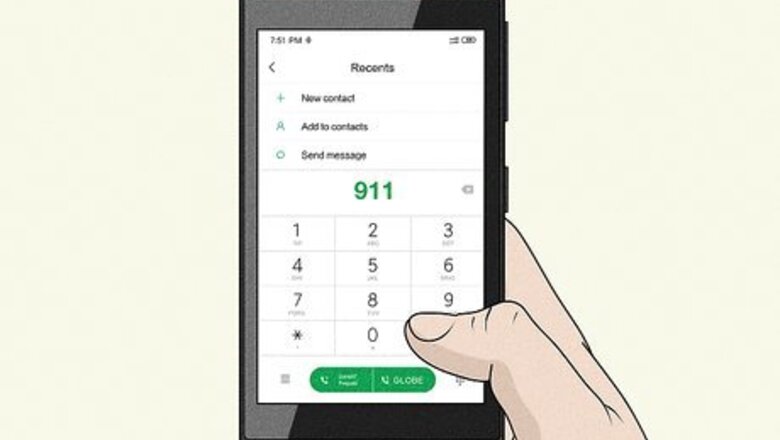
views
X
Research source
A threat against property, on the other hand, might still be a crime, but it's typically considered a theft-related offense.[2]
X
Research source
Calling to Report
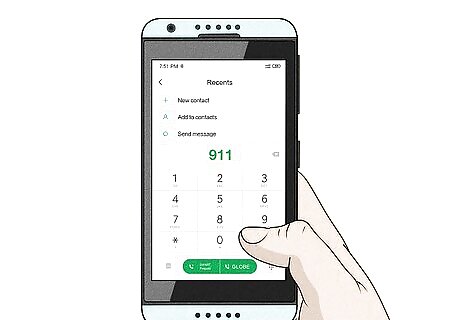
Dial 911 or your local emergency number if you're in immediate danger. Threats are typically meant to scare or intimidate you, but if you think the person intends to follow through with their threats, don't hesitate to call the local emergency number. The operator will send law enforcement to your location as soon as possible for protection and support. If someone has made a bomb threat or similar threat to your location, move to a safe place quickly. Make an effort to evacuate others if it seems possible to do so—for example, by pulling the fire alarm or notifying building security. Try to stay on the phone with the operator until the police arrive. They'll do what they can to comfort you and help you remain calm. Do what you can to assure your own safety as well as the safety of your loved ones—particularly if they've also been threatened. For example, if the person threatened to kill you and your family, you might need to make some phone calls to let your family members know about the threat. If you're in a situation where you can't talk to the operator, call 911 and leave the line open. Don't call and hang up, or they're going to call you right back, which could draw unwanted attention to you.

Use the local police's non-emergency number if the threat isn't imminent. Even you don't feel like you're in immediate danger, you might still want to report the threat—perhaps to create a record in case something happens in the future or to alert police to the activity. The non-emergency number is typically posted on the website for your local police. If your area has an information service, such as 411, you could also call that number to get the non-emergency number. For example, if someone threatens you online, but you know they don't live near you or aren't capable of hurting you immediately, use the non-emergency number. Threats to property aren't typically considered emergencies either, unless it's something like a bomb threat that might involve catastrophic damage or loss of life. For example, if someone threatens to break your car windows and slash your tires, that's not considered an emergency. Some police departments might have several different non-emergency numbers. Just pick the one that best corresponds to your location and situation.

Tell the officer who you are and where you're located. When a dispatch officer answers, give them your full legal name and address. If you're currently not at home, give them the address where you currently are as well as your home address. The officer might ask you for additional information about yourself, such as your gender or age. Typically, this information is used for statistical purposes.

Provide the officer with detailed information about the threat. Fill the officer in on who is threatening you, what they've threatened to do, when they threatened you, and where they threatened you. Provide as many details as possible but don't guess or assume anything—only tell the officer what you know to be true. Tell the officer all the different ways in which the person threatened you. For example, if they threatened you on social media and called or texted you, tell the officer about all of these instances. If you know the person who is threatening you, tell the officer about your current or previous relationship with the person. For example, you might've dated the person in the past or they might be a member of your family.

Follow up with an officer in person if necessary. Often, an officer will visit your location to review any evidence you have and confirm your identity. The officer might also ask you questions to confirm the information you provided over the phone. Typically, you'll have to sign the notes drafted by the officer. Read them over carefully to make sure they're accurate and let the officer know if anything's incorrect. If your report is assigned to a detective for investigation, that detective will likely reach out to you as well.
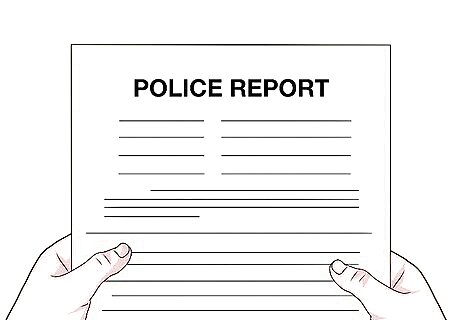
Get a copy of the written report for your records. It can take up to a week for the police to generate the final written report. Typically, you'll have to make a visit down to the police station in person to pick it up. If you're not able to do that, call and ask if they can mail you one. Save your police report for your records. If a detective was assigned to your case, get their name and contact information so you can call them directly if the person threatens you again.
Telling Police in Person

Find the nearest local police station. Go to the local law enforcement website for a list of police stations. You can also use the GPS app on your phone to find a police station and get directions from your current location. Generally, you should report the threats where they occur. However, this applies to the city as a whole—not individual precincts. So, for example, if you live in Los Angeles, you can generally use the most convenient police station, even if you received the threats on the other side of town.

Visit the police station during normal business hours. While police stations are typically staffed 24/7, you'll have better luck filing a police report if you go during the day. Try to go first thing in the morning when there's usually a shorter wait. Bring a valid photo ID so the police can verify your identity. In many cities, you also have the option of having an officer dispatched to your location to take the report. If you use this option, you might be waiting for a while before the officer arrives, particularly on busy days.

Provide the officer with detailed information about the threats. Give the officer as much information as you have about the person threatening you and the threats they made, including where and how they threatened you. If you have a prior relationship with the person who threatened you, let the officer know this as well. The officer might ask you questions to learn more information about the situation. Answer all questions as completely and truthfully as you can, even if they don't seem relevant to you. The more information you can give the more the police will have to go on. At the same time, if you don't know something, just say so—don't guess, assume, or make something up. If you have screencaps, text messages, phone records, emails, or other evidence of the threats, offer those to the officer. They might take your originals or make copies of them.

Sign the report to authorize an investigation into the threats. Because filing a false police report is against the law, police typically need your signature before they'll act on your report. Usually, you'll sign in front of the officer who has verified your ID. Read the officer's notes carefully before you sign the report. If you see anything that's incorrect or inaccurate, speak up!

Get a copy of the final written report for your records. It can take several days for the police to complete the final written report. The officer who takes the report will let you know when you can pick it up. Keep it for your records—you'll also need to refer to it if you have any additional information for the police. For example, if the person threatens you again, call the police non-emergency number and tell them you have additional information to add to a report you filed. Give them the report number and they'll update the report. When you get your copy of the report, ask if a detective has been assigned to your case. If they have, get their name and contact information so you can reach out to them directly if you need to.
Notifying Police Online
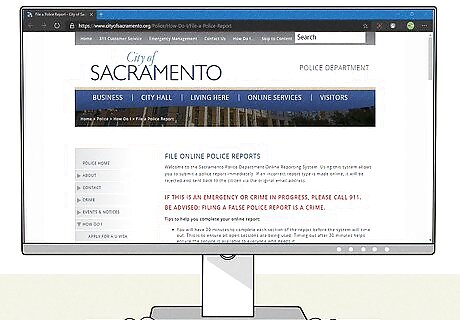
Go to the website of local law enforcement. Look up your local police department online to find their website, then navigate to the online reporting page. Read the information about online reporting carefully to see if your situation falls into a category of crimes you can report online. In the wake of the 2020 COVID-19 pandemic, many police departments accept online reports on a wider range of issues than they usually do. However, different departments have their own rules regarding the types of crime you can report online.
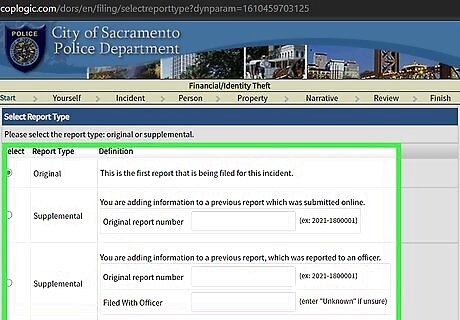
Fill out detailed information about the threats. Provide specific details about who threatened you, what they threatened, when they made the threats, and how they made those threats. If you have space, include any background information that you think might be helpful to police. For example, if you're receiving online threats, you might not have a lot of information about the identity of the person threatening you. But police will find their screen name, photos, names of friends, and any other identifying information useful. Some online report forms allow you to attach digital files. If you have screencaps or copies of emails or other communication from the person who threatened you, attach those. If there's no option to attach files, simply include a line letting police know you have that evidence available. The police department typically issues a temporary report number for you to use until the final report is created. Use that number if you need to change or update anything in your report.

Follow up with the police department to get your written report. Usually, an officer reviews your report and writes up an official police report. They might contact you if they need any additional information for that report. It typically takes about a week for the police to issue the final report. Typically, the police will send an email to the email address you provided with your online report to let you know when the written report is ready. They might also attach a digital copy of the report to the email.
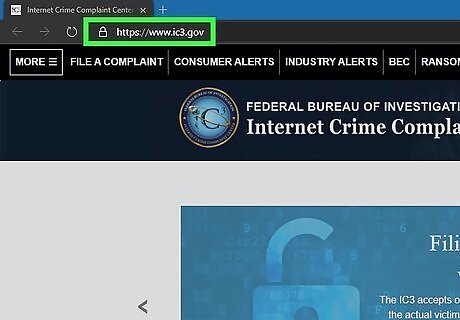
Use the Internet Crime Complaint Center (IC3) for internet threats. Go to https://www.ic3.gov if someone is making threats online and you want to let the FBI know about it. Fill out the form with as many specific details about the threats and the person making them as possible. You can also cut and paste information, such as email headers or the text of the threats. Since the IC3 doesn't collect evidence, keep any screen caps, emails, or other evidence you've gathered in a safe place. An investigating officer might want to see these later. The IC3 processes your report and sends it out to the appropriate law enforcement agencies. If you've provided contact information, an officer investigating the threats might reach out to you.



















Comments
0 comment